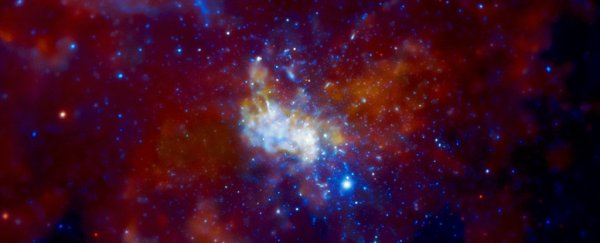Sagittarius A*, the supermassive black hole at the centre of the Milky Way, isn't exactly rowdy. It's not classified as an active galactic nucleus - one of those galactic cores that glow exceedingly brightly as they feast on copious amounts of material from the surrounding space.
However, the brightness of our galaxy's centre does fluctuate a little across the electromagnetic spectrum on a daily basis. Astronomers have now confirmed that, over the last few years, Sgr A*'s most energetic X-ray flares have been increasing.
The paper has been accepted in the journal Astronomy & Astrophysics, and is already available on arXiv while it undergoes the peer review process. The results support the conclusions of earlier studies that have found our galactic centre is indeed getting restless.
Specifically, a team of French and Belgian researchers led by astrophysicist Enmanuelle Mossoux of the University of Liège in Belgium continued their work from a 2017 paper that found the rate of bright flares had increased threefold from 31 August 2014.
The earlier work - also co-authored by Mossoux - studied X-ray data on Sgr A* from the XMM-Newton, Chandra and Swift observatories collected between 1999 and 2015. They detected 107 flares in total. Not only were the brightest X-ray flares increasing after August 2014, the faintest ones had decreased from August 2013.
To find out if these trends have continued, Mossoux and colleagues collected and analysed the data from all three telescopes between 2016 and 2018. They detected 14 more flares to add to the previous data for a total of 121.
Then, they analysed all the flares, using the previous methods, and revised methods to determine the flare rate and distribution. These found that one of the earlier conclusions was incorrect - there was no decrease in the rate of faint flares; these remained pretty steady over the period covered by the data.
"However, this did not change our global result: a change in flaring rate is found for the brightest and most energetic flares at the same date as was found in the previous section," the researchers wrote in their paper.
Although these studies both only refer to X-ray flaring, they're not the only hint in recent times that something is up with Sgr A*. Last year, the black hole flared 75 times its usual brightness in near-infrared - the brightest we've ever observed it in those wavelengths.
The team analysing the near-infrared observations had a dataset of 133 nights from 2003; and last year, they found three nights on which Sgr A* near-infrared activity was elevated. They said in their paper that this was "unprecedented compared to the historical data."
(Don't worry, Sgr A* is 26,000 light-years away. The big bad black hole can't get you.)
Mossoux and her team have also checked to see if the 2019 activity is consistent with their recent findings. They analysed the Swift data from 2019, and found four bright flares, the largest number ever observed in a single campaign, confirming that the black hole is not settling down.
Additionally, XMM Newton and Chandra data from 2019 - due for release this year - could reveal even more about the peculiar X-ray activity, and what might be causing it - whether it's accretion, or something else, such as the tidal disruption of passing asteroids.
Observations across other wavelengths could reveal more information too. Continued observations in the near-infrared, and radio wave observations, could help us figure out what's making Sgr A* stir.
"Since 2014, the activity of Sgr A* thus increased in several wavelengths," the researchers wrote.
"Additional multiwavelength data are required to conclude on the persistence of this increase and to obtain clues on the source of this unprecedented activity of the supermassive black hole."
The research has been accepted by Astronomy & Astrophysics, and is available on arXiv.
